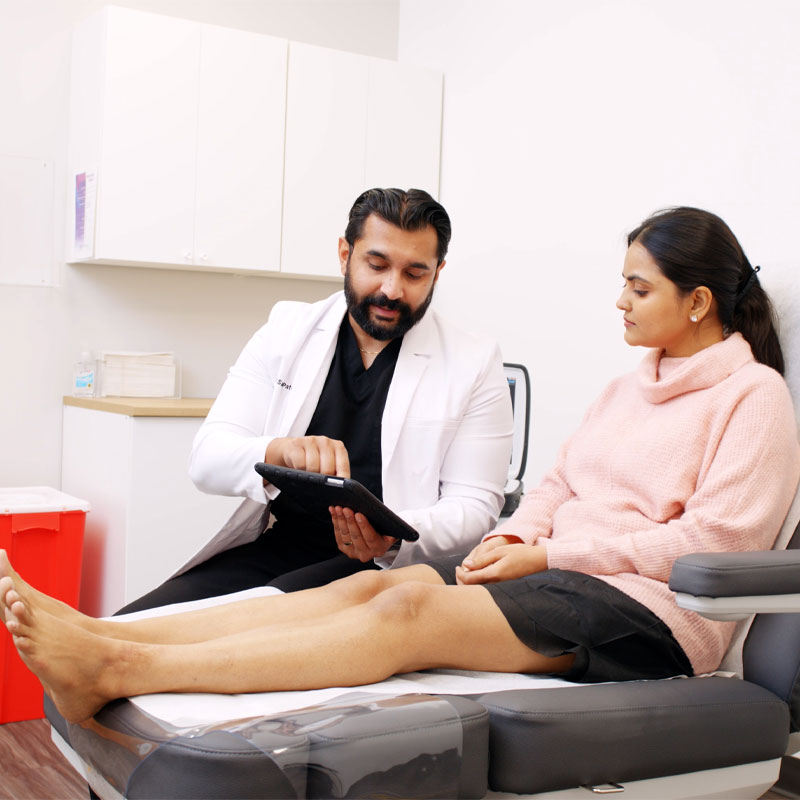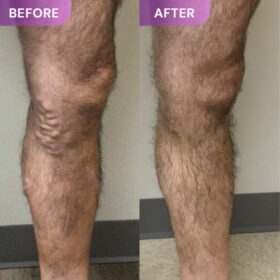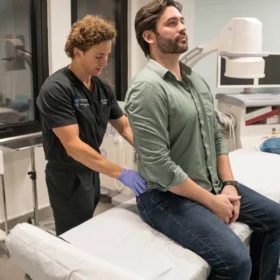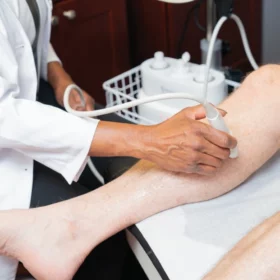At Vein Treatment Clinic, we understand the discomfort that can come with varicose and spider veins. Fortunately, advancements in medical technology have provided a range of non-surgical treatment options that are highly effective in addressing these issues. In this guide, we walk you through some of the best non-surgical vein treatment options available today.
Compression Stockings
Compression stockings are a tried-and-true method for managing the symptoms of varicose veins and preventing their progression. These stockings apply pressure to the legs, helping to improve blood flow and reduce swelling. While compression stockings don’t eliminate varicose veins, they can significantly alleviate discomfort and prevent further complications. They are often recommended as a supplementary treatment alongside other non-surgical options.
Benefits of Compression Stockings:
- Improved Blood Circulation: Compression stockings apply gentle pressure to the legs, promoting better blood flow and reducing the risk of blood pooling in the veins.
- Reduced Swelling: Compression stockings can alleviate swelling and discomfort associated with varicose veins by aiding in the movement of blood and fluids out of the legs.
- Symptom Relief: Compression stockings can effectively relieve symptoms such as heaviness, achiness, and fatigue in the legs, improving overall comfort and mobility.
- Preventive Care: Wearing compression stockings regularly can help prevent the progression of varicose veins and reduce the likelihood of blood clots or skin ulcers.
- Non-Invasive: Unlike surgical procedures, compression stockings offer a non-invasive and relatively low-risk option for managing varicose vein symptoms.
- Versatility: Compression stockings come in a variety of styles, lengths, and compression levels to suit individual needs and preferences, making them suitable for everyday wear in various settings.
Endovenous Laser Ablation
Endovenous laser ablation (EVLA) is a minimally invasive procedure that uses laser energy to seal off varicose veins. During the procedure, a thin laser fiber is inserted into the affected vein, where it delivers targeted energy to the vein wall. This causes the vein to collapse and be reabsorbed by the body, eliminating the appearance of varicose veins. EVLA is highly effective and typically requires minimal downtime, making it a popular choice among patients seeking non-surgical vein treatment.
Radiofrequency Ablation
Similar to EVLA, radiofrequency ablation (RFA) is a minimally invasive procedure that uses heat energy to treat varicose veins. Instead of laser energy, RFA utilizes radiofrequency waves to heat and seal off the affected vein. This results in the closure of the vein and the redirection of blood flow to healthier veins. RFA is known for its high success rates and low risk of complications, making it a safe and effective option for non-surgical vein treatment.
VenaSeal
VenaSeal is a relatively new non-surgical treatment option for varicose veins that utilizes a medical adhesive to seal off the affected vein. During the procedure, a small amount of adhesive is injected directly into the vein, causing it to close and reroute blood flow to healthier veins. VenaSeal offers several advantages, including minimal discomfort and the absence of heat or energy-based therapies. It is an excellent option for patients seeking a quick and virtually painless solution to their varicose veins.
ClariVein
ClariVein is a unique non-surgical vein treatment option that combines mechanical and chemical methods to address varicose veins. During the procedure, a rotating wire is inserted into the affected vein, where it agitates the vein wall while simultaneously delivering a sclerosing agent. This combination of mechanical disruption and chemical sclerosant helps to collapse the vein and promote its closure. ClariVein is often favored for its simplicity and efficiency, offering patients a relatively painless and effective solution to their vein issues.
Ambulatory Phlebectomy
Ambulatory phlebectomy is a minimally invasive surgical procedure that is often considered alongside non-surgical options for the treatment of varicose veins. During the procedure, small incisions are made in the skin near the affected vein, through which the vein is removed using specialized tools. Ambulatory phlebectomy is particularly effective for larger varicose veins that may not respond as well to non-surgical treatments. While it does involve minor surgery, ambulatory phlebectomy offers excellent results with minimal scarring and downtime.
Sclerotherapy
Sclerotherapy is a versatile and widely used non-surgical treatment option for both varicose and spider veins. During the procedure, a sclerosing agent is injected directly into the affected vein, causing it to collapse and fade from view. Sclerotherapy is highly effective for smaller veins and can often be completed in a single office visit. It is a safe and minimally invasive option that yields excellent cosmetic results.
Foam Sclerotherapy
Foam sclerotherapy is a variation of traditional sclerotherapy that involves injecting a foamy solution into the affected vein. The foam helps to displace blood within the vein, allowing for better contact between the sclerosing agent and the vein wall. This results in more efficient vein closure. Foam sclerotherapy is particularly effective for larger varicose veins and can be combined with other non-surgical treatments for optimal results.
Benefits of Minimally Invasive Vein Treatments:
- High Success Rates: Minimally invasive treatments such as endovenous laser ablation and radiofrequency ablation have been shown to have high success rates in treating varicose veins, often achieving long-lasting results.
- Minimal Downtime: Compared to traditional surgical procedures, minimally invasive treatments typically involve shorter recovery times and minimal disruption to daily activities, allowing patients to return to their normal routines quickly.
- Reduced Risk of Complications: Minimally invasive procedures carry a lower risk of complications such as infection, scarring, and nerve damage compared to open surgery, making them a safer option for many patients.
- Local Anesthesia: Many minimally invasive vein treatments can be performed under local anesthesia, eliminating the need for general anesthesia and reducing the associated risks and recovery time.
- Cosmetic Benefits: Minimally invasive treatments often result in minimal scarring and better cosmetic outcomes compared to traditional surgery, making them an attractive option for patients concerned about the appearance of their legs.
- Customized Treatment Plans: Minimally invasive vein treatments can be tailored to each patient’s specific needs, allowing for personalized care and optimal results. Treatment plans may include a combination of procedures to address multiple vein issues simultaneously.
- Preservation of Surrounding Tissue: Minimally invasive treatments target the affected veins directly, minimizing damage to surrounding tissues and nerves, leading to quicker recovery and fewer complications.
- Outpatient Procedures: Many minimally invasive vein treatments can be performed on an outpatient basis, meaning patients can return home the same day of the procedure, avoiding the need for hospitalization.
- Minimal Discomfort: Minimally invasive procedures typically involve smaller incisions or needle punctures, resulting in less post-procedural pain and discomfort.
- Improved Quality of Life: By effectively treating varicose veins and relieving associated symptoms such as pain, swelling, and heaviness, minimally invasive treatments can significantly improve patients’ quality of life and overall well-being.
- Long-Term Results: Minimally invasive treatments for varicose veins address the underlying cause of the condition, leading to long-term improvement in vein function and appearance.
Lifestyle Changes to Improve Vein Health:
- Regular Exercise: Engaging in regular physical activity, such as walking, swimming, or cycling, helps to improve circulation and strengthen the muscles that support vein function.
- Maintain a Healthy Weight: Being overweight or obese can put added pressure on the veins, leading to the development or exacerbation of varicose veins. Maintaining a healthy weight through a balanced diet and regular exercise can reduce this risk.
- Elevate Legs: Elevating the legs above the heart level for short periods throughout the day can help promote blood flow back to the heart and reduce swelling and discomfort in the legs.
- Avoid Prolonged Sitting or Standing: Prolonged periods of sitting or standing can lead to poor circulation and increased pressure on the veins. Taking breaks to stretch and move around can help improve circulation and reduce the risk of vein issues.
- Wear Compression Stockings: Wearing compression stockings can provide additional support to the veins and help improve circulation, especially during periods of prolonged sitting or standing.
- Avoid Tight Clothing: Tight clothing, especially around the waist, groin, or legs, can restrict blood flow and exacerbate vein issues. Opt for loose-fitting, comfortable clothing that allows for unrestricted movement.
- Stay Hydrated: Drinking an adequate amount of water throughout the day helps maintain healthy blood viscosity and promotes optimal circulation, reducing the risk of blood pooling in the veins.
- Quit Smoking: Smoking can constrict blood vessels and impair circulation, increasing the risk of vein issues. Quitting smoking can improve overall cardiovascular health and reduce the likelihood of developing varicose veins.
- Eat a Balanced Diet: Consuming a diet rich in fiber, vitamins, and minerals supports overall vascular health and can help prevent conditions that contribute to vein issues, such as obesity and high blood pressure.
- Manage Stress: Chronic stress can contribute to poor circulation and exacerbate vein issues. Incorporating stress-reducing activities such as meditation, yoga, or deep breathing exercises into your daily routine can promote vein health and overall well-being.
Explore Your Non-Surgical Vein Treatment Options
There are several highly effective non-surgical treatment options available for varicose and spider veins. From compression stockings to innovative procedures like endovenous laser ablation and VenaSeal, there are solutions to fit every patient’s needs and preferences. At Vein Treatment Clinic, we specialize in providing personalized care and cutting-edge treatments to help you achieve healthier, more beautiful legs without surgery. Schedule a consultation with us today to learn more about your non-surgical vein treatment options.












